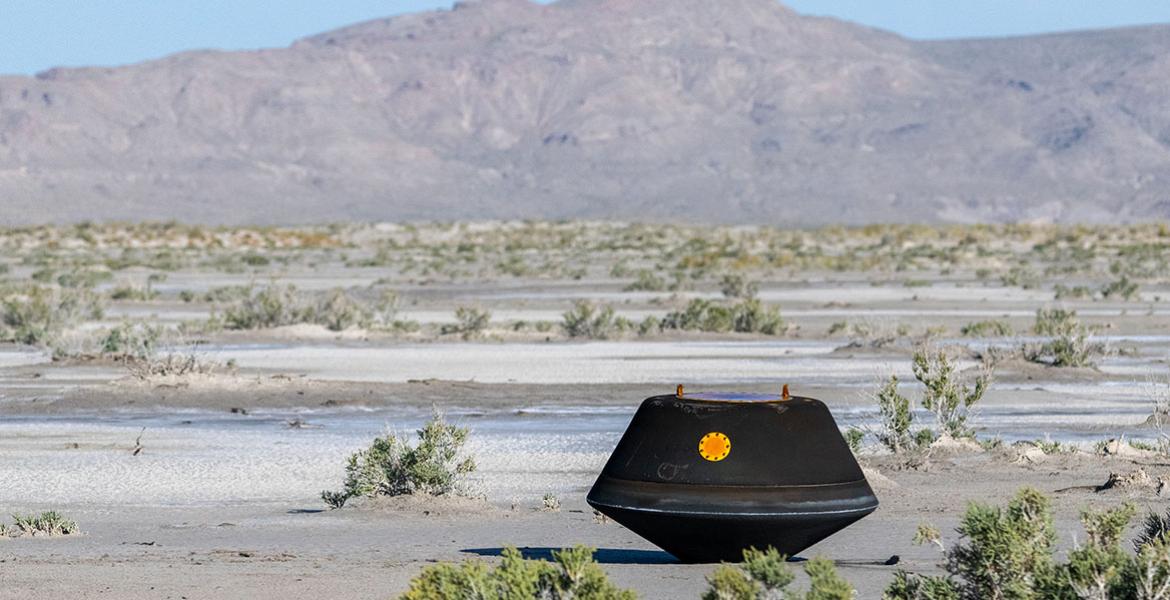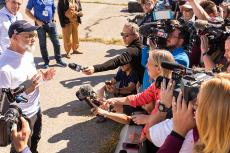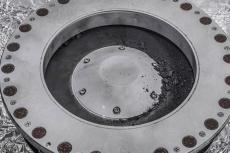UA’s Alfie Norville Gem & Mineral Museum Displays a Piece of the Asteroid Bennu
A small piece of the asteroid Bennu – a dark pebble with well-defined structure and texture – has made the Alfie Norville Gem & Mineral Museum one of only three places in the world to display an extraterrestrial rock sample collected in space, other than the moon.
"It almost seems like something that you would shake out your shoe after a long hike. If you look closely, you can see some different textures in it, some different colors,” said the museum’s director, Violetta Wolf. “Putting it in its display case really was a humbling moment – recognizing what just passed through our hands."

NASA portions out educational samples to recognize the potential to inspire and encourage future scientists, said Wolf. And this piece is bigger than the than the sand-size science samples of Bennu currently under analysis at the University of Arizona.
In all, NASA’s OSIRIS-REx mission, led by the UA, brought 121.6 grams, or 4.29 ounces of material, to Earth on Sept. 24, 2023. Of that amount, UA scientists received 200 milligrams, or approximately 7 thousandths of an ounce, of asteroid material for scientific study.
And while that small piece of asteroid Bennu sits in its case, as well as two others like it for public viewing – at Space Center Houston in Texas and the Smithsonian National Museum of Natural History in Washington, D.C. – their storis have only just begun.
As OSIRIS-REx scientists are beginning to probe the stuff left over from the formation of the solar system about 4.6 billion years ago, they will make countless discoveries, and with each one, a little bit more will be known about the display samples.
The Latest Findings
Initial sample studies show evidence of high carbon content and water, which together could indicate the building blocks of life on Earth. In February 2024, the mission team announced the surprising presence of phosphates – chemical compounds containing phosphorus that are found in high concentrations in extraterrestrial oceans – in the sample. This discovery prompted OSIRIS-REx principal investigator Dante Lauretta to speculate that the asteroid “may be a fragment of an ancient ocean world.” One working hypothesis is that this parent body was destroyed by a catastrophic collision, liberating the shard we know today called Bennu, which eventually made its way into near-Earth space.
In March 2024, scientists including assistant professor Pierre Haenecour of the UA’s Lunar and Planetary Laboratory revealed the latest on what they’re finding at the Lunar and Planetary Science Conference, according to Scientific American.
Their analyses are preliminary, but it seems that, billions of years ago, Bennu was part of a water-soaked world, one with a beating geologic heart and an abundance of prebiotic organic material. In many respects, this world could have borne a passing resemblance to the early, lifeless Earth.
Some of the sample’s microscopic grains reveal that Bennu’s odyssey began before the sun’s first fires burned, meaning that planetary scientists can use it as a toehold in their quest toward answering some of their field’s most enduring and monumental queries: What minerals were present at the start of the solar system, and where did they come from?
A key question in that investigation is: What went into making Bennu’s original (or “parent”) body? Clues reside within its presolar grains, crystals that condensed before the sun existed – "basically, the building blocks of our solar system," said Haenecour.
Other questions the sample team hopes to make progress toward answering include how water came to Earth. As to how life began, Bennu isn't expected to provide concrete answers. However, life couldn’t exist without a suite of carbon-bearing compounds such as amino acids. One idea is that these formed in the spaces between the stars before asteroids like Bennu brought these ingredients to Earth.
“We know [that asteroids] can deliver these things to Earth. But the key step is: How did they become life? We need to know that inventory to be able to answer that,” said Ashley King, a meteoriticist at London’s Natural History Museum and an OSIRIS-REx science team member.
And already the team has identified a long list of organic molecules, including a suite of amino acids, present in the sample.




